
First and Only Weekly Online Fanzine Devoted to the Life & Works of Edgar Rice Burroughs Since 1996 ~ Over 15,000 Webpages in Archive |

First and Only Weekly Online Fanzine Devoted to the Life & Works of Edgar Rice Burroughs Since 1996 ~ Over 15,000 Webpages in Archive |

The Barsoom novels are a little like the Oz novels of Burroughs’s friend and eventual California neighbor L. Frank Baum, whose estate, Ozcot, was not far from Burroughs’s Tarzana. Both are partly reflections of how the authors saw the United States at the time. But even more, they’re escapes from it, written by relatively late bloomers who found in writing a fulfillment that had earlier been denied them. |
 |
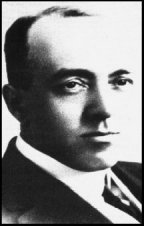
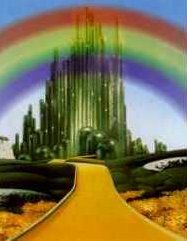
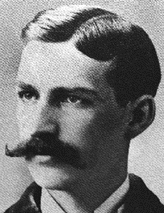
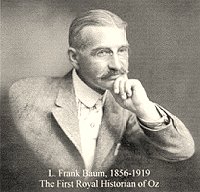
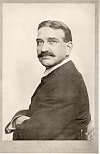
LYMAN FRANK BAUM
1856-1919
"When I was young I longed to write a great novel that should win me fame. Now that I am getting old my first book is written to amuse children. For, aside from my evident inability to do anything "great," I have learned to regard fame as a will-o-wisp which, when caught, is not worth the possession; but to please a child is a sweet and lovely thing that warms one's heart and brings its own reward..."L. Frank BaumBorn: May 15, 1856, in Chittenango, New York, United States
Died: May 6, 1919, in Hollywood, California, United StatesLyman Frank Baum was an American writer best known for his series of books about the fantastic land of Oz. Baum wrote approximately sixty novels in his lifetime. He often used pen names, such as Louis F. Baum, George Brooks, Laura Bancroft, so as not to compete with himself. His books are renowned more for their storytelling appealthan their literary qualities.
His parents were Benjamin and Cynthia Baum. He was born into a family in which four of the five children had died in infancy. Frank himself had a defective heart and, thus, was a very protected child. Baum's father made a fortune in the Pennsylvania oil rush of 1860. He invested in Syracuse real estate and moved the family to large mansion in a city suburb.
Baum was educated in schools in Syracuse, New York and Peekshill Military Academy. He wasn't suited for either the rigid military life or educational facilities, and spent only two years at the academy. His hatred of it is also reflected in his books. He often criticized the treatment of the North American Indian (see below) Ironically, one of his sons became a soldier and another became a teacher.
For much of Baum's life, he was out of money. He had many interests and livelihoods: reporter; poultry farmer; founding editor of New Era, Bradford, Pennsylvania; actor, producer, and theater manager; general store owner; editor of the Aberdeen Saturday Pioneer; and traveling salesman. He married Maud Gage in 1882. Together, they had four sons. Maud was fascinated with the supernatural and the occult, causing Baum to complain that his house was haunted.
In 1899, his first book, Father Goose, was a popular success. This book was developed from the fairy tales he told his children. He became editor and publisher of The Show Window magazine from 1897 to 1902, a position that allowed him to concentrate on
his writing.In 1900, he began a series of fairy tales set in the land of Oz. There are many stories as to how Mr. Baum came up with the name of Oz, one being that when asked by one child what the name of this marvelous land was, his eye happened to catch sight of his filing cabinet, which read "O-Z". The first in this series was the well-known Wizard of Oz, which was criticized at the time for its lack of moral principle. Although the book included traditional fairy tale characters, such as witches, the book modernized the tale by including technology, machinery and gadgets.
Before his death, Baum wrote fourteen books about Oz. He was the founding director of Oz Film Manufacturing Company, Los Angeles, which failed after its first year.
Plagued by poor health, Baum died nine days before his sixty-third birthday in Southern California. His family's financial means were ensured by the many manuscripts that were published posthumously. The enormously successful musical film, The Wizard of Oz, was made in 1939, after his death.
A Baum & Oz Bibliography
The Wonderful Wizard of Oz (Baum, 1900)
The Marvelous Land of Oz (Baum, 1904)
Ozma of Oz (Baum, 1907)
Dorothy and the Wizard in Oz (Baum, 1908)
The Road to Oz (Baum, 1909)
The Emerald City of Oz (Baum, 1910)
The Patchwork Girl of Oz (Baum, 1913)
Tik-Tok of Oz (Baum, 1914)
The Scarecrow of Oz (Baum, 1915)
Rinkitink in Oz (Baum, 1916)
The Lost Princess of Oz (Baum, 1917)
The Tin Woodman of Oz (Baum, 1918)
The Magic of Oz (Baum, 1919)
Glinda of Oz (Baum, 1920)
The Royal Book of Oz (Thompson--although R&L editions say Baum, 1921)
Kabumpo in Oz (Thompson, 1922)
The Cowardly Lion of Oz (Thompson, 1923)
Grampa in Oz (Thompson, 1924)
The Lost King of Oz (Thompson, 1925)
The Hungry Tiger of Oz (Thompson, 1926)
The Gnome King of Oz (Thompson, 1927)
The Giant Horse of Oz (Thompson, 1928)
Jack Pumpkinhead of Oz (Thompson, 1929)
The Yellow Knight of Oz (Thompson, 1930)
Pirates in Oz (Thompson, 1931)
The Purple Prince of Oz (Thompson, 1932)
Ojo in Oz (Thompson, 1933)
Speedy in Oz (Thompson, 1934)
The Wishing Horse of Oz (Thompson, 1935)
Captain Salt in Oz (Thompson, 1936)
Handy Mandy in Oz (Thompson, 1937)
The Silver Princess in Oz (Thompson, 1938)
Ozoplaning With the Wizard of Oz (Thompson, 1939)
The Wonder City of Oz (Neill, 1940)
The Scalawagons of Oz (Neill, 1941)
Lucky Bucky in Oz (Neill, 1942)
The Magical Mimics in Oz (Snow, 1946)
The Shaggy Man of Oz (Snow, 1949)
The Hidden Valley of Oz (Cosgrove, 1951)
Merry Go Round in Oz (McGraw and Wagner, 1963)
The Project Gutenberg Etext of
The Wonderful Wizard of Oz
by L. Frank Baum
http://www.cs.cmu.edu/People/rgs/wizoz10.html
IntroductionFolklore, legends, myths and fairy tales have followed childhood through the ages, for every healthy youngster has a wholesome and instinctive love for stories fantastic, marvelous and manifestly unreal. The winged fairies of Grimm and Andersen have brought more happiness to childish hearts than all other human creations.
Yet the old time fairy tale, having served for generations, may now be classed as "historical" in the children's library; for the time has come for a series of newer "wonder tales" in which the stereotyped genie, dwarf and fairy are eliminated, together with all the horrible and blood-curdling incidents devised by their authors to point a fearsome moral to each tale. Modern education includes morality; therefore the modern child seeks only entertainment in its wonder tales and gladly dispenses with all disagreeable incident.
Having this thought in mind, the story of "The Wonderful Wizard of Oz" was written solely to please children of today. It aspires to being a modernized fairy tale, in which the wonderment and joy are retained and the heartaches and nightmares are left out.
L. Frank Baum
Chicago, April, 1900.
The Project Gutenberg Etext of
The Marvelous Land of Oz
by L. Frank Baum
http://www.cs.cmu.edu/People/rgs/ozland-table.html
Author's NoteAFTER the publication of "The Wonderful Wizard of OZ" I began to receive letters from children, telling me of their pleasure in reading the story and asking me to "write something more" about the Scarecrow and the Tin Woodman. At first I considered these little letters, frank and earnest though they were, in the light of pretty compliments; but the letters continued to come during succeeding months, and even years.
Finally I promised one little girl, who made a long journey to see me and prefer her request, -- and she is a "Dorothy," by the way -- that when a thousand little girls had written me a thousand little letters asking for the Scarecrow and the Tin Woodman I would write the book, Either little Dorothy was a fairy in disguise, and waved her magic wand, or the success of the stage production of "The Wizard of OZ" made new friends for the story, For the thousand letters reached their destination long since -- and many
more followed them.And now, although pleading guilty to long delay, I have kept my promise in this book.
L. FRANK BAUM.
Chicago, June, 1904
This article by L. Frank Baum appeared in
The Aberdeen Saturday Pioneer
January 3, 1891 (after the Wounded Knee massacre)"The peculiar policy of the government in employing so weak and vacillating a person as General Miles to look after the uneasy Indians, has resulted in a terrible loss of blood to our soldiers, and a battle which, at best, is a disgrace to the war department. There has been plenty of time for prompt and decisive measures, the employment of which would have prevented this disaster.
"The PIONEER has before declared that our only safety depends upon the total extirmination of the Indians. Having wronged them for centuries we had better, in order to protect our civilization, follow it up by one more wrong and wipe these untamed and untamable creatures from the face of the earth. In this lies safety for our settlers and the soldiers who are under incompetent commands. Otherwise, we may expect future years to be as full of trouble with the redskins as those have been in the past.
"An eastern contemporary, with a grain of wisdom in its wit, says that `when the whites win a fight, it is a victory, and when the Indians win it, it is a massacre."
-- L. Frank Baum
BAUM REFERENCE LINKS
The Man Behind the Curtain: L. Frank Baum and The Wizard of Oz
by Linda McGovern
E-Text Editions of Books by L. Frank Baum
The Online Literature Library of L. Frank Baum Books
Baum's Oz Books - in Esperanto
Directory of Baum and Oz Books Online
Oz Reference Resources
Readers Choice ~ Ratings and Reviews of the L. Frank Baum Books
The Baum Bugle
The International Wizard of Oz Club
Wizard of Oz Links Page
Baum Encyclopedia of the Self - Hypertext
The Life and Adventures of Santa Claus by L. Frank Baum
Encarta
Comptons
L. Frank Baum
May 15, 1856 ~ May 6, 1919
